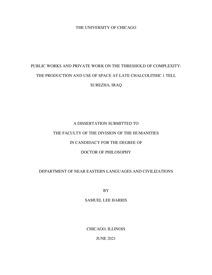The 5th and 6th millennia in the Near East, falling “between the revolutions” represented by the emergence of sedentism & domestication on the one hand, and urbanism and complex society on the other, are important for understanding changes in human social, economic, and political organization in the region. Tell Surezha in northern Iraq was inhabited from at least the Ubaid period of the 6th millennium through the Late Chalcolithic of the 5th and 6th millennia, and exposures of the Late Chalcolithic 1 (LC 1) settlement offer an opportunity to investigate social structures and dynamics at a moment of cultural change as the interregional interactions represented by the widespread Ubaid material cultural assemblage began to be replaced by more localized material. In this dissertation I ask how the residents of LC 1 Surezha organized their activity—and their society—across space. How were houses and households organized in spatial and social terms? How and where were objects and foods produced, used, and consumed? Were there major changes in the organization of domestic economies in a clear trajectory toward specialization and complexity? How were domestic and nondomestic spheres of activity and access created and used? I use the analysis of microdebris—the very small remains of various kinds of human activity deposited and preserved in the matrix of use surfaces—in conjunction with other archaeological data to argue that production and consumption in the LC 1 remained largely organized by and centered in the household, that domestic spaces were multifunctional and relatively undifferentiated in terms of activity, and that the trend toward increasing economic specialization and centralization that would flower in later periods is evident only in very limited ways in the LC 1. At the same time, a critical change in the use of social space is evident at Surezha in the form of a large nondomestic building complex, for which the microarchaeological data suggests major restrictions of access and use. While the idea of “public architecture” as a marker of socioeconomic complexity has been widespread for over a century, I put forward a different way of thinking about space by proposing the “limited-access public space” as a fundamental technology of the expanding power of political, social, and economic elites.
Sunday, January 15, 2023
Public Works and Private Work on the Threshold of Complexity: The Production and Use of Space at Late Chalcolithic 1 Tell Surezha, Iraq
Subscribe to:
Post Comments (Atom)






No comments:
Post a Comment